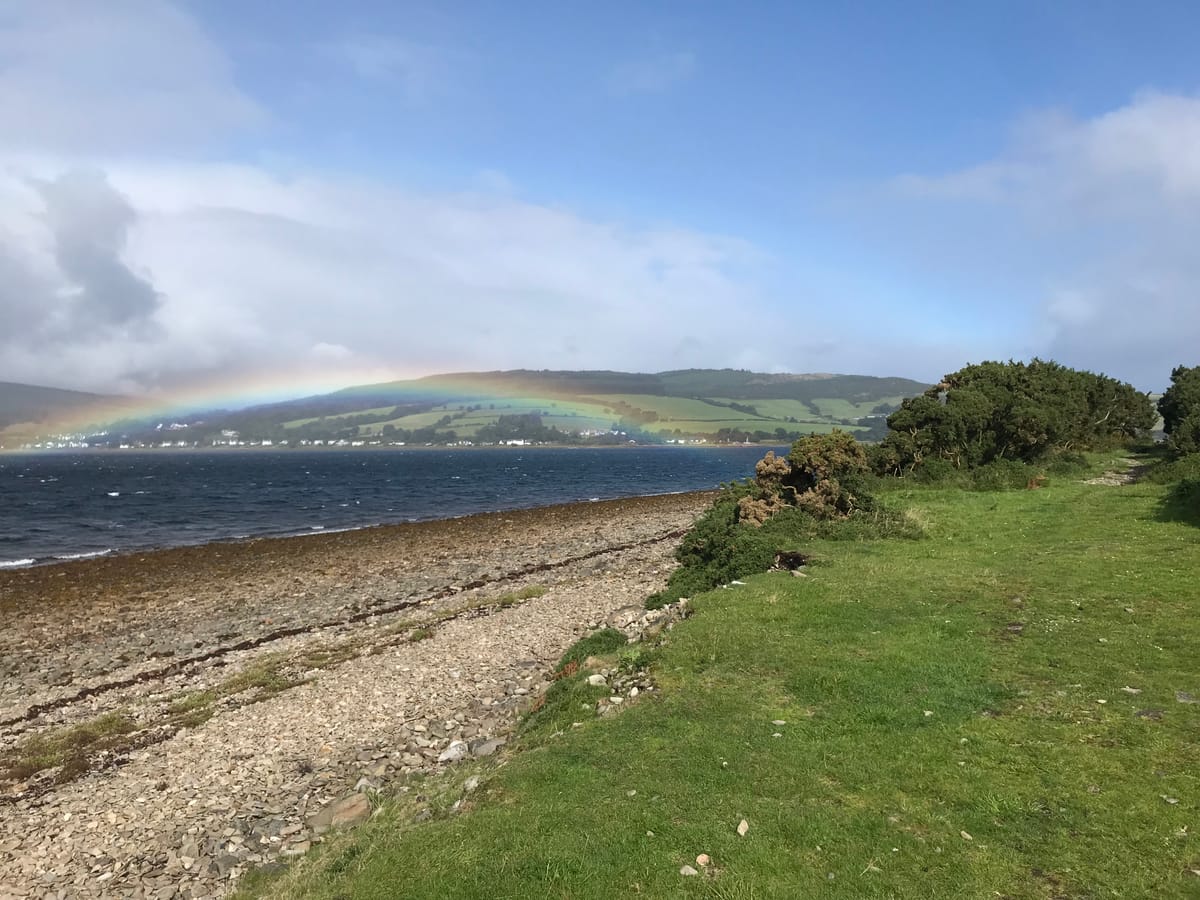convergence: listening

post 4 of #100DaystoOffload
The library on the Holy Isle is a place for serendipitous stumbling into teachings I wouldn't otherwise encounter. On retreat there last year, I came across The Work of This Moment, by and about Toni Packer, a former Zen buddhist. This year, I couldn't find it again, though I wanted to read more. By that point I had forgotten name of book and author alike, and couldn't locate any expected notes-to-self reminders. Today, for some reason, I was prompted to search again. A web search on "US woman zen buddhist leaving" or similar hadn't given any joy in the past, but in this instance chatGPT was very handy.
Here I am idly scrolling some of the pages online; an act of reacquaintance. I pause then linger on a page from the introduction by Lenore Friedman:
Again and again she emphasizes the importance of nondefensive listening. [...] We need to listen to each other, and to ourselves, without any threat, she says. And this can happen only if there really is no threat—which is no easy matter at all. It takes "tremendous attention, and energy of awareness, not to be pulled into all these tendencies blindly". It is so easy not to look at what is happening in ourselves when we are defensive, ambitious, envious, or disparaging of others. Where do these reactions come from? What is the source of disharmony, war, the lack of relationship among human beings? We must look and ask and sit with these questions. Again and again: What is it?
Introduction to The Work of This Moment, p.xxiii
Yes. Yes. It was probably in reading such passages on the island shore last year that I felt that body-full warmth of resonance, that wordless fervour and clarity, that Yes.
Speaking more in the ~rational or analytical mode I can say that this is where I found evidence that the text was relevant to my interests in dialogue, listening, connecting across difference, peace. (But how dispassionate and dull that sounds! and perhaps something is lost in translation...)
Reading these words again today I am struck by a sense of convergence and pattern recognition. Here is Toni Packer from the Zen tradition talking about the importance of deep listening. And when I read that, I connect it to other thinkers, other writing about the relationship between listening, openness and change.
One is Carl Rogers (and Richard Farson) in the 1957 article that (to my understanding) originally shared the concept of active listening with the world—a phrase that has itself found resonance and use very widely, and to this day.
[Active] listening brings about changes in people's attitudes toward themselves and others, and also brings about changes in their basic values and personal philosophy. People [...] become more emotionally mature, more open to their experiences, less defensive, more democratic, and less authoritarian.
When people are listened to sensitively, they tend to listen to themselves with more care and make clear exactly what they are feeling and thinking. Group members tend to listen more to each other, become less argumentative, more ready to incorporate other points of view. Because listening reduces the threat of having one's ideas criticized, the person is better able to see them for what they are, and more likely to feel that his [sic] contributions are worthwhile.
Rogers and Farson (2015 [1957]), pp.3-4
Rogers and Farson go on to provide a theoretical explanation for why active listening helps openness, clarity and care in oneself and interaction with others. We have images and stories of our selves, positive and negative, realistic and unrealistic. These form what we think of as our self, our personality. And this "self-picture" is a filter through which we engage with the world and make sense of our experiences. Things that "fit" the "way we need to think about ourselves": we accept them. Whereas we reject, downplay or ignore anything that is challenging. It can be "so necessary" to maintain our picture or story of ourselves that we are "threatened by anything which would tend to change it". It isn't made explicit or explored in detail, but implied that the reason we cling to these images/stories of ourselves is because it might be "the only thing" we have to identify ourselves, to mark ourselves out with a sense of individual coherence and continuity in the world.* (I guess at this point Buddhists might talk about the four types of clinging including clinging to self.)
So, back to how this relates to openness vs defensiveness, according to Rogers and Farson:
This is why direct attempts to change this individual or change his [sic] self-picture are particularly threatening. He is forced to defend himself or completely deny the experience. This denial of experience and defense of the self-picture tend to bring on rigidity of behavior and create difficulties in personal adjustment.
The active listening approach, on the other hand, does not present a threat to the individual's self-picture. He does not have to defend it. He is able to explore it, see it for what it is, and make his own decision as to how realistic it is. And he is then in a position to change.
If I want to help a [person] reduce [their] defensiveness and become more adaptive, I must try to remove the threat of myself as [their] potential changer. As long as the atmosphere is threatening, there can be no effective communication. So I must create a climate which is neither critical, evaluative, nor moralizing. It must be an atmosphere of equality and freedom, permissiveness and understanding, acceptance and warmth. It is in this climate and this climate only that the individual feels safe enough to incorporate new experiences and new values into [their] concept of [themselves].
Rogers and Farson (2015 [1957]), pp.5-6
I come to Rogers partly by way of nonviolent communication, because the formulator of NVC Marshall Rosenberg was a student of Rogers. Also the concept of active listening is generally floating around in spaces and communities I'm associated with - including academia. I will come back to this topic in future because the different versions of active listening that are out there, and working out their lineages/diffusion, interests me.
It's also through NVC that I come to Jim Manske and his Pathways to Nonviolent Communication book, which at its core is a printed text version of the very helpful self-development and self-assessment tool called the "Pathways to Liberation: Matrix of Self-Assessment" (or just "the Matrix" for short). More context can be provided another time (!) but what is of interest today is the where Manske is talking about "working through edges", i.e. "borders between levels of development" about any given skill.
A person who becomes aware that a previously unknown skill exists is moving from unskilled to awakening in regard to that skill. Confronting this edge may stimulate both resistance to change and curiosity.
Both of these reactions emerge from human biology and become reinforced by beliefs. When we humans settle into a life pattern that seems predictable, our nervous systems naturally relax, and this relaxation saves us energy. We enjoy being able to reliably predict what comes next, so we love it when things stay just so. Change can feel scary, because we don't know what will come after the change. By definition, change gives way to surprise, and some surprises can be harmful.
And yet [...] Human beings thrive on novelty and variety—but only if we feel safe and secure. Once we have anchored into a sense of security, we naturally and cautiously venture into new territory, eager for discovery. Sometimes surprises are delights!
[...] This is the lesson to remember at the edge between unskilled and awakening: Do the best you can to ensure that you feel safe to proceed. From the point of view of needs consciousness, this means: Attend to your sustenance, safety, and security, and honor the strategies that help you feel safe.
For the sake of attention spans, I am going to stop here for now, having presented these complementary excerpts. I hope you can see some of the connections, the continuities, complementarities and possible questions arising when they are brought into dialogue.
Tomorrow or in the coming days we can pick this up and explore...
- What are the implications about developing listening skill and facilitating spaces where deep transformative listening and learning can happen? Or simply, How can I develop the skill of active, nondefensive listening?
- Is this convergence where different people are reaching similar conclusions? Or can we trace or impute any shared reference points?
- Critically engaging with the narratives here, and thinking about the academic or scientific need for evidence and sources and so on—what holds up to scrutiny in what is being claimed here? What "research questions" do I formulate to go out and check if this story, which is a compelling story to me, is sound?
*This approximates, or may today be superseded by, contemporary theories of development and selfhood (which I have only a fuzzy received understanding of myself). When I think about this, what comes up is thinking about cognitive dissonance, for instance; and ideas of in-group vs out-group differentiation.




